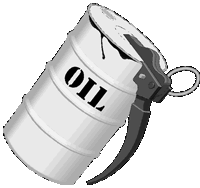|
July 2, 2008
Bubbles & Monster Money
Written by Jeff Thredgold, CSP, President, Thredgold Economic Associates
The doubling of oil prices during the past year from $70 per 42-gallon barrel to above $140 per barrel has heightened emotion levels about what, or who, might be responsible for such a development…
…there seems to be plenty of blame to go around
Believers in market fundamentals would argue that the doubling of oil prices merely reflects a sharp increase in global demand that has simply not been offset with higher levels of oil production. They suggest that rising demand from China and India has been the single most important contributing factor.
These market fundamentalists note that China and India, which include nearly 40% of the world’s population, have recorded real (inflation adjusted) average economic growth rates exceeding 10% and 7% annually during the past seven years. As a result of the associated rise in standards of living and industrial growth, the demand for oil and other commodities has spiked higher.
Others suggest that market fundamentals have combined with a sharp rise in market speculation as the principal reasons for the doubling of oil prices. Increased speculation does clearly seem to be part of the answer as well.
In my mind, market fundamentals justify oil at around $70 per barrel. Rising nuclear tensions between Israel and Iran, combined with oil field violence in Nigeria, account for perhaps another $15 per barrel, representing the “what if” scenario. Another $15 is a function of weakness in the U.S. dollar of recent years. Roughly $40 of the rise is likely tied to oil speculation.
An Aggressive Pool of $$
In my view, there is an enormous pool of very aggressive investment money around the globe (let’s call it Monster Money) that chases those assets with the greatest chance of a substantial gain. Much of this money is in the management hands of hedge funds, pension funds, Wall Street and global commercial banks and investment firms, insurance companies, and sovereign wealth funds.
When this money is flowing in, asset prices can and do move quickly higher. When the asset class falls out of favor, the plunge in prices can also be gutwrenching.
Exhibit one supporting this idea is the powerful rise in technology and internet stocks primarily within the Nasdaq stock market during the second half of the 1990s and the first quarter of 2000. During that time, more and more Monster Money was chasing these highflying stocks, with a feeling among many that prices would continue to rise sharply. Tens of thousands of U.S. investors tapped into credit cards and home equity loans to also chase after these stocks.
The Nasdaq eventually rose 640% to an intraday high of 5132 on March 10, 2000, the culmination of a rally that commenced during June 1994 (Bloomberg.com). The Nasdaq then began a frightening plunge of nearly 80% during the next couple of years.
Exhibit two is the next parking spot of much of this Monster Money. As the Nasdaq lost favor with these aggressive investors, they soon saw enormous upside potential in…
…real estate…both residential and commercial properties…both in the U.S. and around the world
 The sexiest new investment during 2001 through 2006 was in individual properties and bright and shiny new developments in such places as San Diego, Phoenix, Las Vegas, Orlando, and Miami, as well as in London, across France, Spain, Ireland and many more locations. The sexiest new investment during 2001 through 2006 was in individual properties and bright and shiny new developments in such places as San Diego, Phoenix, Las Vegas, Orlando, and Miami, as well as in London, across France, Spain, Ireland and many more locations.
Later to the game were individual investors, including residents of communities far from the glamour. Many of us know of neighbors or friends who bought one or more condominiums in such places as Miami and San Diego, fully expecting to make a 20% or 30% gain on their investment in just a few months. A small share of these “flippers” did quite well…while thousands of others still hold those properties today, with mortgage debt sharply exceeding the value of the properties.
As noted frequently, four states fell into the glamour category for flipping real estate…Arizona, California, Florida, and Nevada. Each state (as well as others) is now in, or flirting with, its own recession, with both residential and commercial property values down sharply.
Similar stories are found of aggressive commercial real estate developers, with stars in their eyes regarding boatloads of money to be made. Too many out-of-market lenders from around the country were more than willing to aggressively finance projects large and small.
Exhibit three is the surge in commodity prices of the past two years. The cycle repeated itself again as the real estate buzz began to fade. In my mind, much of this Monster Money soon shifted to the next “sure thing” of commodities. Gold, silver, and copper led the way during the past few years, soon followed by aggressive investments into oil, natural gas, and coal.
These investments also benefited from the decline of the U.S. dollar of the past few years, resulting in part from housing crisis fears and imminent recession anxiety. The Federal Reserve’s sharp cuts to its key interest rate of the past 10 months also contributed to the dollar’s weakness.
The surge in oil prices has now exceeded that of the spike in Nasdaq stocks of 8 to 14 years ago (Bloomberg.com). Oil at $140 per barrel is up more than 700% when compared to the price of $17.45 per barrel in November 2001.
“There’s nothing different between this mania, the dot-com mania, the real estate mania, the Dow Jones mania of the 1920s, the South Sea bubble and the Dutch tulip-bulb mania,” notes Stephen Schork, president of Schork Group, Inc., a Pennsylvania-based advisor to OPEC, Wall Street firms, and oil companies on the outlook for energy prices. “History repeats itself over and over and over again.”
Critics of aggressive investors note that speculators now control more than 70% of oil futures contracts on the Nymex exchange, versus 37% in 2000 (USA TODAY). Congressional leaders have threatened greater regulation and punishment for “speculators” who interfere in financial markets purely for lucrative profits. Talks regarding the need for higher margin requirements, greater investor disclosure, and stricter trading limits are routine.
Exhibit Four?
In my mind, oil and other commodity prices could decline sharply during the next year. However, we will likely see oil move even higher before that happens.
I see some of the Monster Money seeking to cash out of what has been a profitable move into commodities, including oil, and seeking the next market of opportunity…stocks.
I see more of these investors reminding themselves that those who stay at the party too long can get punished. Many understand that stock market or commodity “bulls” and “bears” can make money…
…but pigs get slaughtered
• Email this article to a friend
• Learn about econAmerica, Jeff’s latest book
|
|
Subscribe to the Tea Leaf
Like what you just read? Have Jeff Thredgold’s Tea Leaf emailed to you free each week. Subscribe today.
|
|
|

“Tea”ser
Misery Loves Company…
If you don’t like paying $4 per gallon of gasoline in the U.S., you would really hate paying $9 to $11 per gallon across Europe.
• Send us a “Tea”ser

“Tea”stimonial
“Thank you for helping to make MHI’s Annual Meeting a huge success. Your presentation was outstanding. We have received great feedback from the meeting participants about your presentation. If anyone ever wants to know how you are to work with, give him or her my name! I have nothing but high praise for you. Thank you for making my job so much easier!”
—Karin M. Soyster, CMP, Director, Meetings and Executive Department, Manufactured Housing Institute
• More testimonials
Invite Jeff Thredgold to speak at your next conference, meeting, or client function
If you like the Tea Leaf, you’ll love Jeff Thredgold’s live presentations. Jeff takes your audience on a timely, engaging, and entertaining tour of the U.S. economy and financial markets. Debunking some of today’s most common economic myths, he offers a clear picture of how the American economy is really performing and what that means for the future of your finances.
• Watch video clips of a Jeff Thredgold presentation.
• Download more information that you can e-mail to other decision makers.
• See Jeff Thredgold’s speaking calendar.
• Tell us about your event using our online form and we will contact you. Or, is there an individual in your organization you would like us to contact?
• Give us a call at 1-888-THREDGOLD (847-3346) to ask about Jeff’s availability and pricing for your event, or for any other information.
|
